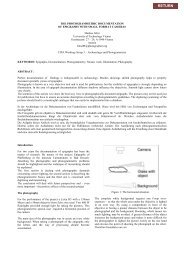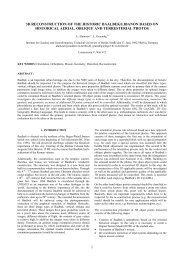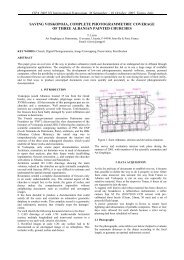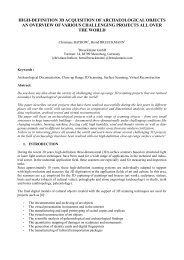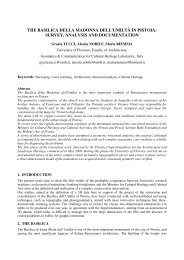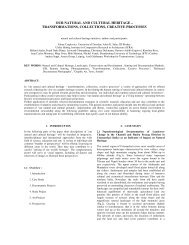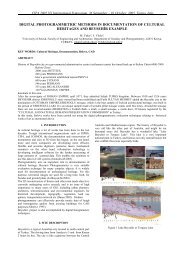CIPA HERITAGE DOCUMENTATION - CIPA - Icomos
CIPA HERITAGE DOCUMENTATION - CIPA - Icomos
CIPA HERITAGE DOCUMENTATION - CIPA - Icomos
You also want an ePaper? Increase the reach of your titles
YUMPU automatically turns print PDFs into web optimized ePapers that Google loves.
ABSTRACT<br />
The multi-image spherical panoramas<br />
as a tool for architectural survey<br />
Gabriele Fangi<br />
Polytechnical University of Marche, Ancona, Italy, g.fangi@univpm.it<br />
The surveys of the interior of two churches in Italy, the<br />
Magdalene’s church in Pesaro, and San Dominic church in Arezzo,<br />
are shown and described as examples of a new photogrammetric<br />
technique. The first church is one of the most noticeable<br />
baroque architecture in the Marche region and it has been designed<br />
by the famous architect Luigi Vanvitelli in 18th century,<br />
the second one is a large and simple church in Arezzo. The proposed<br />
technique is based on the multi-image spherical panoramas.<br />
For the formation of the plane image of the spherical panoramas<br />
the commercial software has been used. The spherical<br />
panorama can be regarded as the analogical recording of the angular<br />
observations of a theodolite having its center in the center<br />
of panorama. But to be set in operational conditions as a theodolite,<br />
the spherical panorama has to recover two rotation angles<br />
to set the verticality of its principal axis. The estimation of such<br />
rotation angles can be performed both in a preliminary phase prior<br />
to the plotting or in a unique phase in a block adjustment.<br />
Control points, control directions, geometric constraints such as<br />
verticality and horizontality of space lines, can be used. In these<br />
study-cases almost no one of such control information was necessary,<br />
but the only block adjustment was sufficient. The block<br />
adjustment finally furnishes the estimation of the unknown points<br />
coordinates together with the six orientation parameters per panorama,<br />
three translations and three rotations, by means of the<br />
known geodetic equations of the horizontal direction and the zenith<br />
angle, (modified to take into account the two horizontal correction<br />
angles), that are nothing else than the collinearity equations<br />
of the spherical panoramas. The technique of the spherical<br />
panoramas has previously been experimented and used for the<br />
survey of two of the most noticeable Italian squares, Piazza del<br />
Popolo in Ascoli Piceno and Piazza del Campo in Siena. By that<br />
time, to be able to use the panoramas, besides the angular corrections,<br />
further polynomial corrections were necessary, gotten<br />
from a dense network of control points (100-200), (Fangi, 2006).<br />
In the case under examination not only such corrections were not<br />
needed but also no control point was used. The procedure improvement<br />
can be explained with the shorter distances, with the<br />
good improvement of the Stitching software, (that thanks also to<br />
the ceiling texture, produced better panoramas), and finally with<br />
the improvement of the adjustment algorithms, via the block adjustment.<br />
The image distortion is automatically corrected by the<br />
software itself in the rendering phase, by merging the overlapping<br />
image frames. The interior orientation is skipped. For the time<br />
being, the final plotting accuracy is limited by the quality of the<br />
panoramas and by the resolution of the spherical images. In the<br />
shown examples the width was 10.000 and 15.000 pixels for all<br />
the panoramas, corresponding to an angular accuracy of 0.04-<br />
0.03 g, therefore very scarce. The 3d plotting was performed<br />
with monoscopic multi-image observations. In the first example<br />
the block adjustment supplied, besides the orientation parameters,<br />
the coordinates of about 600 points, observed in at least<br />
three panoramas. The achieved accuracy is in the order of few<br />
the centimetres say σ x = σ y = ±0.02 m and σ z = ± 0.03m. The<br />
advantage of the spherical panorama in comparison to classical<br />
photogrammetry consists in the greater completeness of the information<br />
due to its 360° amplitude, giving a synoptic view of the<br />
whole environment. A single panorama can replace many image<br />
frames; a couple of panoramas can substitute many photogrammetric<br />
models. The spherical panoramas are very simple, fast<br />
and easy to realize, they are very economic, and they are a very<br />
useful and powerful tool for the documentation and survey of the<br />
cultural heritage.<br />
Key words: Multi-image spherical panoramas, simulation, adjustment,<br />
simple systems.<br />
Introduction<br />
Till now the only metric applications of images panning to<br />
360°, were mainly those gotten with high resolution rotating<br />
cameras (5, Luhmann, Tecklenburg, 2004, 6, 7, Schneider,<br />
Maas, 2004). The technique here proposed uses on the con-<br />
tHe multI-Image sPHerIcal Panoramas as a tool For arcHItectural survey<br />
21



